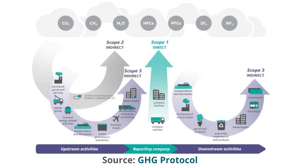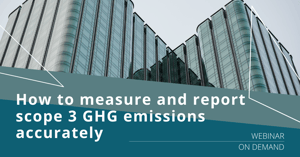Talk to us
 Through its award-winning software solutions and client support team of reporting experts, Greenstone enables its clients to accurately calculate and report on all scope 3 categories. Greenstone’s suite of sustainability, ESG and supply chain software solutions provide integrated GHG emissions calculations following the GHG Protocol.
Through its award-winning software solutions and client support team of reporting experts, Greenstone enables its clients to accurately calculate and report on all scope 3 categories. Greenstone’s suite of sustainability, ESG and supply chain software solutions provide integrated GHG emissions calculations following the GHG Protocol.
The difference between scope 1, 2 & 3 GHG emissions
The GHG Protocol classifies a company's GHG emissions into three categories or 'scopes', to unify reporting and accounting of emissions worldwide.
Scope 1 emissions: Covers all direct emissions from owned or controlled sources, such as energy consumption, fuels, vehicles, etc.
Scope 2 emissions: Covers indirect emissions from the generation of purchased electricity, steam, heating or cooling energy consumed by the company.
Scope 3 emissions: Covers all indirect emissions that occur in the value chain of the reporting company, meaning that the emissions are out of the company’s operational control, including both upstream and downstream emissions. As scope 3 emissions are the result of activities from assets not owned by the company, one company’s scope 3 emissions may originate from another company’s scope 1, Scope 2 or even scope 3 emissions. Scope 3 emissions are split between 15 categories, which in return are organised into two types of emissions, whether they are upstream or downstream in the value chain.
Why are scope 3 emissions important?
Most organisations have typically focused on monitoring and documenting scope 1 and 2 emissions since they are relatively easy to interpret and data is readily accessible. However, is often the case that scope 3 emissions are by far the largest proportion of an organisations’ carbon footprint; sometimes larger than scope 1 and scope 2 combined.
There are a variety of reasons why scope 3 emissions reporting has become more common in recent years. Global sustainability reporting frameworks are an important driver for scope 3 emissions reporting. Both GRI and CDP have increased the scope of scope 3 transparency standards, allowing businesses to be completely mindful of all of their impacts, including the indirect ones.
Another key driver for measuring scope 3 emissions is the increase in the setting of ambitious emission reduction commitments such as Science Based Targets (SBTS) and Net-Zero pathways. For example, should your scope 3 emissions account for more than 40% of your overall emissions, then the SBTi requires you to set a target to cover this impact. Net-zero goals demand similarly long term and well-defined emission reduction pathways. In order to be able to achieve net-zero goals, organisations need to not only disclose and understand their scope 3 emissions, but they also need an accurate approach that enables them to actually reduce these emissions.
What are the benefits of measuring a company's scope 3 emissions?
Calculating and reporting scope 3 emissions can enable an organisation to:
- Evaluate their performance more effectively.
- Focus on generating value from their emissions strategies.
- Create demonstrable impact from their emissions reductions.
The approach you take to scope 3 emissions reporting will be determined by your company's environmental targets and overall business strategy. Cutting indirect emissions can help you boost your brand image, increase supply chain performance, or upgrade goods to be lower carbon.
Measuring scope 3 emissions across your value chain will also help identify suppliers and investments who excel in sustainability performance and those who fall short. You will boost productivity and lower costs across your value chain by partnering with your suppliers and portfolio companies and encouraging the improvement of ESG performance giving you a competitive edge and higher margins.
If business travel and commuting are a major source of indirect emissions, implementing flexible work arrangements and collaborating with employees to minimise business travel and commuting will result in a cleaner and more efficient workforce, as well as a reduction in emissions.
Greenstone & scope 3 emissions calculation and reporting
Greenstone enables its clients to reliably measure and report in all scope 3 categories through its award-winning software solutions and customer support team of sustainability experts. Greenstone's suite of sustainability, ESG and supply chain software solutions provides advanced and integrated scope 3 GHG emissions calculations in line with the GHG Protocol.
Greenstone’s Enterprise sustainability reporting software enables scope 1, 2 & 3 GHG emissions calculations, including value chain and supply chain. Users can upload data from any category and automate that calculation process. This means that all 15 scopes 3 categories can be tracked against long term targets in our Enterprise Environment module.
SupplierPortal and InvestorPortal can be used to collect primary data from external organisations. So, data directly gathered from suppliers and portfolio companies is converted into carbon emissions data and automatically shared across our platform to ensure the clients have an accurate and responsive scope 3 emissions inventory.
Learn more about Scope 3 emissions reporting: Explore Greenstone's on-demand webinar gallery












